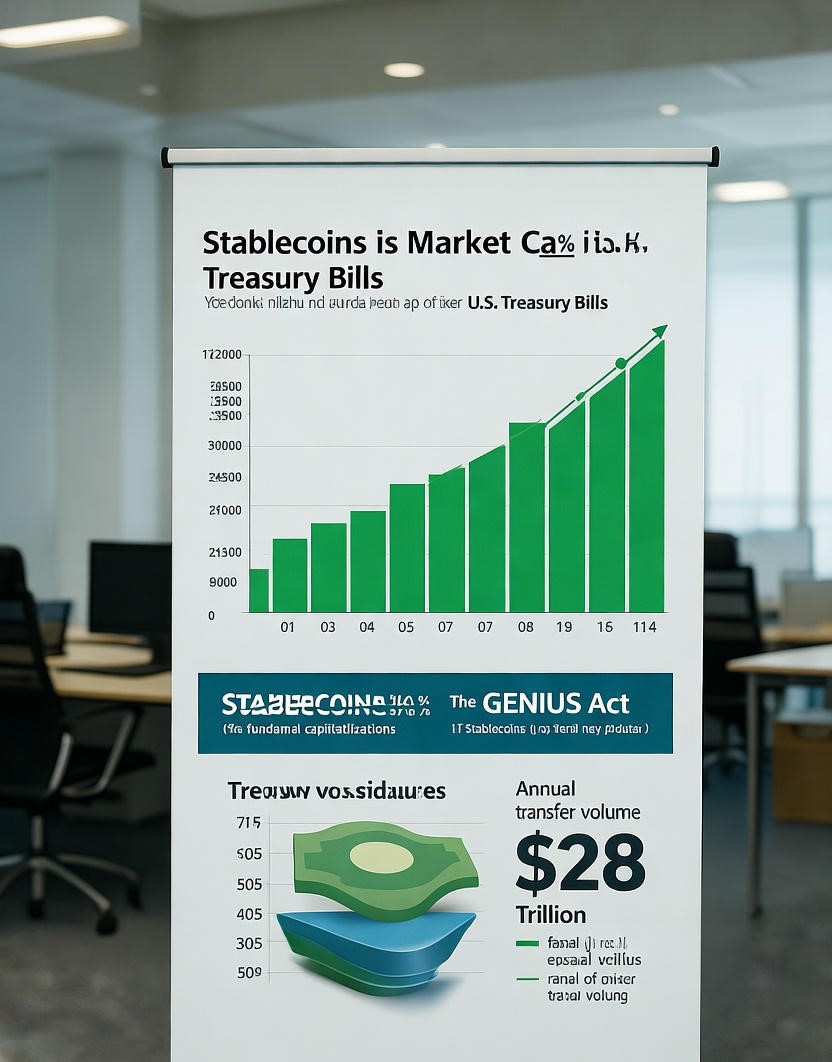Stablecoins were designed to be the bridge between two worlds: offering the high-speed, low-cost, and decentralized nature of cryptocurrency with the price stability of traditional assets like the U.S. dollar. For years, however, they have operated on the fringes of mainstream finance, hindered largely by regulatory uncertainty.
That era is now ending. The recent passage of the GENIUS Act in the U.S. Senate marks a watershed moment, granting stablecoins a newfound legitimacy and a clear operational framework. Coupled with their staggering $28 trillion in annual transfer volume—which now surpasses the combined processing volume of Visa and Mastercard—stablecoins are poised to redefine the global financial landscape.
What is a Stablecoin? The Digital Dollar Explained
At its core, a stablecoin is a cryptocurrency whose value is pegged to a stable asset, most often the U.S. dollar. Each unit of a dollar-pegged stablecoin is designed to be redeemable for one dollar, maintaining its value through reserves of assets.
The GENIUS Act seeks to cement this stability into law by mandating:
-
1:1 Reserves: Every stablecoin in circulation must be backed by one dollar’s worth of high-quality liquid assets, such as Treasury bills or Federal Reserve deposits.
-
Regular Audits: Issuers must undergo frequent, transparent audits to verify their reserves.
-
Anti-Money Laundering Protocols: Strict programs must be implemented to prevent illicit finance.
-
Ban on Interest Payments: Stablecoins cannot pay interest, distinguishing them from bank deposits.
Three Core Use Cases: More Than Just a Digital Dollar
The potential of stablecoins extends far beyond simple price stability. Their utility can be summarized in three key areas:
1. A Bank-Alternative Store of Value: Stablecoins offer a way to hold digital cash outside the traditional banking system. While their attractiveness in the U.S. may be limited without interest payments, they are a powerful tool for savers in countries suffering from unstable currencies or runaway inflation.
2. Revolutionizing Cross-Border Payments: They enable individuals and corporations to transfer value across borders almost instantly and at a minimal cost, 24/7. Their “programmable” nature can also automate complex processes like vendor payments, while the immutable blockchain record reduces fraud and errors.
3. Unlocking Blockchain Marketplaces: Stablecoins eliminate currency risk within the crypto ecosystem. Users can trade, lend, or borrow on decentralized platforms using digitized dollars instead of volatile assets like Bitcoin, making the entire process more predictable and accessible.
The Investment Impact: What Stablecoins Mean for Your Portfolio
It is crucial to understand that stablecoins are not an investment. Their value is designed to be constant, removing the prospect of capital gains. Their role is transactional, not for wealth creation.
However, their impact on the investment universe is significant:
A Challenge to Volatile Cryptocurrencies: Many users drawn to Bitcoin for its payment utility may now prefer stablecoins for transactions, benefiting from their stability and increasing regulatory safeguards.
A New Source of Demand for U.S. Debt: This is perhaps the most profound impact on traditional finance. The GENIUS Act would require stablecoin issuers to hold reserves in “high-quality liquid assets” like short-term Treasury bills. As the stablecoin market grows, so does this built-in demand for U.S. government debt. The market cap of stablecoins is already nearly 5% of the outstanding short-term Treasury market. This growing demand could help support Treasury prices and cap yields, especially in an era of elevated government issuance.
The Bottom Line
While you won’t get rich by holding a stablecoin, their infrastructure is quietly becoming a force in global finance. By combining regulatory clarity with proven, massive-scale utility, stablecoins are no longer a peripheral crypto experiment. They are emerging as a fundamental pillar of a faster, more transparent, and more accessible financial system.

